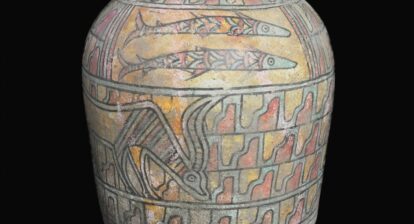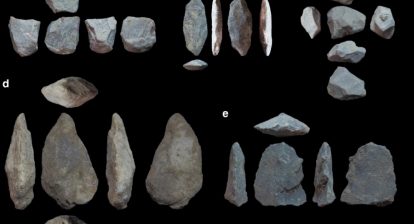More and more chapters are being added to the story of humanity, as new techniques to extract and study ancient DNA take our understanding of our ancestors to unprecedented levels. And one thing is very clear: they roamed around a lot and they were horny. This is what European and Central Asian DNA told us.
(Watch this VLOG on ancient Africans and how our ancestors interbred with other species)
South Asian DNA has been more difficult to come by due to the hotter climate in which it is usually found, making preservation harder than the European samples. But recent advances in extraction and analytical techniques have led to the emergence of a clearer picture of the formation of South Asian populations.Two recent studies provided insights into who South Asian are and where they came from. They tell us that just like everywhere else on this planet, human mobility has played a major role in their ancestry. But before we get to what these two studies tell us, let’s rewind the story just a tiny bit.
Lack of DNA evidence has meant that we had little understanding of how South Asian populations were formed. Most of the hypotheses were based on archaeological evidence. Then, analysis of Mitochondrial DNA (passed from female to offspring) suggested that the inhabitants of India had been indigenous for thousands of years. However, Y-chromosome evidence, which was analysed subsequently, showed connections to Western Eurasians (Iranian or Central Asian). This indicates that men from there migrated into the sub-continent, while women remained local.
An extensive study published in 2018, analyzed the complete genome. It built on the genetic understanding that there were two separate groups in ancient India: the Ancestral North Indians (ANI) and Ancestral South Indians (ASI), who according to David Reich, a geneticist from Harvard Medical School, are as different from each other as Europeans and East Asians today.
This study looked at the genome of 612 ancient individuals, including samples from eastern Iran, an area called Turan that now covers Uzbekistan, Turkmenistan and Tajikistan, Kazakhstan, and South Asia.This data was compared with that taken from present-day individuals, including 246 distinct groups in South Asia. The analysis opens our eyes further to that unique part of our nature: our desire to move. And the story that emerged is that of various groups traveling and mixing with each other.
Firstly, there were the South Asian hunter-gatherers (referred to as Ancient Ancestral South Indians), related to modern day populations of the Andaman Islands. These were the original inhabitants of the Indian sub-continent, descending from the “out of Africa” migration around 50,000 years ago.
(Check out my photoblog on the Harrapan city known as Mohen Jo Daro and my photoblog on the Great Wall of Pakistan called Rannikot)
Then around 9,000 years ago, (7,000 BCE), Iranians entered the sub-continent. They mixed with some of the South Asian hunter-gatherers in the North, and created the Indus Valley Civilization (IVC), also known as the Harappan Civilization. Meanwhile, many other South Asian hunter-gatherers were pushed further south.
Around 2,000 BCE, steppe pastoralists (known previously as “Aryan” but generally as Indo-Iranian) moved south into the sub-continent, encountered the Indus Valley population, perhaps causing some upheaval but mainly mixing with them. This resulted in now some of the Indus Valley population moving south, mixing even more with the Ancient Ancestral South Indians (or South Asian hunter-gatherers) to form the Ancestral South Indian (ASI) population.
(Read What Happened at Easter Island?)
Meanwhile, in the north, the steppe pastoralists mixed much more with the Indus Valley population that remained there, creating the Ancestral North Indian (ANI) group. Subsequently, most modern South Asian populations are a result of further mixing between ANI and ASI.
What this diverse DNA analysis showed was that Indus Valley people are the single most important source of ancestry in South Asia. This has now been reiterated by a study published in Cell in 2019. The individual whose genome was analyzed in this study is a woman found in a cemetery in Rakhigarhi, India (150 km north of Delhi), who lived between 2,800 to 2,300 BCE. The researchers have concluded that she belonged to the IVC from archaeological and genetic evidence.
And her genome also shows that while it fits as a mixture of people related to ancient Iranians (the largest component) and Southeast Asian hunter-gatherers, a surprising component is that the Iranian related ancestry is not from Iranian agriculturists, as previously thought, but from Iranian hunter-gatherers who predate the rise of agriculture by 2,000 years. And here is the kicker: this means that agriculture was not brought into the Indian sub-continent by Iranian farmers but developed in India separately (and probably simultaneously with Iran). Bear in mind though, this is just one individual. As more ancient DNA becomes available, the story might change yet again.

Graphic Abstract from Cell, 2019
The other study also published in 2019, confirms this. While agriculture spread into Iran and Turan (Central Asia) through the movement of people from Anatolia (just like in Europe), the story in South Asia is quite different. The Indus Valley populations were a genetic mixture of early hunter gatherers from Iran and ancient hunter gatherers from South Asia and developed farming separately from Iranian agriculturists. It also confirms the presence of the ubiquitous Yamnaya steppe-patoralists, who contributed to the ANI, together with the IVC people and likely spread the distinctive features shared between Indo-Iranian and Balto-Slavic languages.
This is not the whole story though. There are those in India, who share more affinity with East Asians (those speaking Sino-Tibetan languages) in the mountains of North India. There area also pockets of eastern and central tribal groups that speak Austro-asiatic languages related to Cambodian and Vietnamese (probably descended from those that brought rice farming to South Asia and Southeast Asia. India (and South Asia) is a melting pot. It is also likely to be the area where crop systems from the Near East (wheat and barley) and China (rice) met each other.
(Check out my VLOG on an ancient fort in Pakistan)
So, what do we have? Human beings are and have always been a mixture. There are literally no pure races – in fact the word race itself is meaningless. Just like Europe, South Asians too are descended from diverse people. The end result is messy, complicated mixtures that have brought us a diversity of languages and cultures. That is what we should celebrate.





mobile legends hack version 2019
Keep this going please, great job!